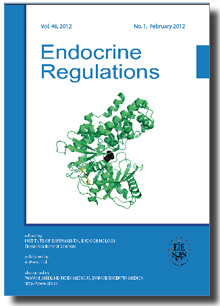Journal info
|
||
Select Journal
Journals
Bratislava Medical Journal Endocrine Regulations 2015 2014 2013 2012 2011 2010 2009 2008 2007 2006 2005 2004 2003 General Physiology and Biophysics Neoplasma Acta Virologica Studia Psychologica Cardiology Letters Psychológia a patopsych. dieťaťa Kovove Materialy-Metallic Materials Slovenská hudbaWebshop Cart
Your Cart is currently empty.
Info: Your browser does not accept cookies. To put products into your cart and purchase them you need to enable cookies.
Endocrine Regulations Vol.46, No.2, p.67-71, 2012 |
||
| Title: Dehydroepiandrosterone in the type 1 diabetes mellitus | ||
| Author: M. Duskova, H. Hruskovicova, M. Hill, L. Starka | ||
| Abstract: Objective. Dehydroepiandrosterone (DHEA) is believed to exert, besides others, positive effects on the insulin resistance or its secretion and glucose metabolism. There are several reports dealing with the DHEA levels and its effects in the type 2 diabetes mellitus, but less information is available on the type 1 diabetic subjects. Recently, a report dealing with the lack of the age-dependent decline of the DHEA levels in the type 2 diabetic subjects was published. The aim of the present study was to answer the question whether a comparable change in the aging pattern of the DHEA and its sulphate could be detected in the type 1 diabetes mellitus. Methods. The data regarding the DHEA and dehydroepiandrosterone sulphate (DHEA-S) concentrations in the serum obtained from 116 patients with the type 1 diabetes mellitus and 259 controls were gathered from the database of the Institute of Endocrinology (Prague, Czech Republic). Results. No significant differences in the level of the DHEA-S were found between the type 1 diabetics and controls either in men or women. However, lower DHEA levels were found in the type 1 diabetic women, but not in men. The age-dependent declines of both the DHEA and DHEA-S were similar to those in controls. Conclusion. In contrast to the type 2 diabetes, the levels of DHEA-S in the type 1 diabetic patients were practically identical with those in controls. In contrast to men, in women, the DHEA basal levels were lower than those seen in controls. The age dependence of both hormones followed the pattern of the decline in controls. |
||
| Keywords: dehydroepiandrosterone, dehydroepiandrosterone sulphate, age and sex differences, age-dependent decline | ||
| Year: 2012, Volume: 46, Issue: 2 | Page From: 67, Page To: 71 | |
| doi:10.4149/endo_2012_02_67 |
||
|
Price:
10.00 €
|
||
|
|
||

